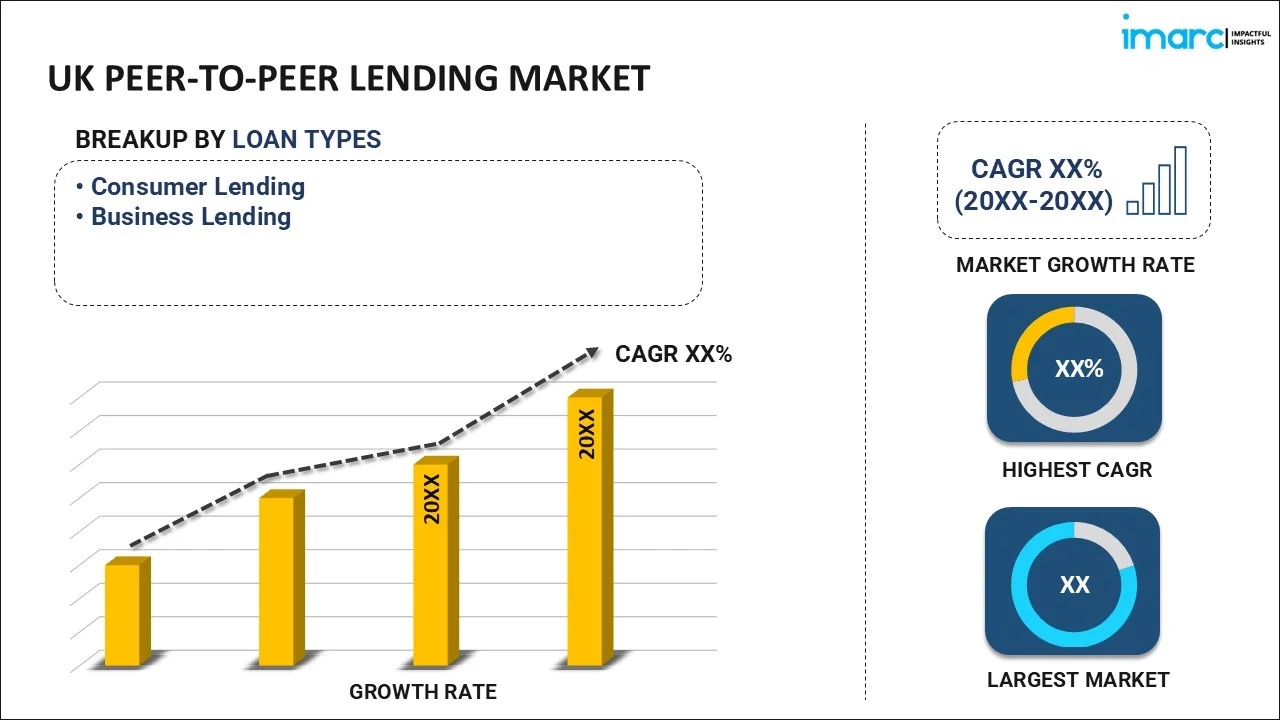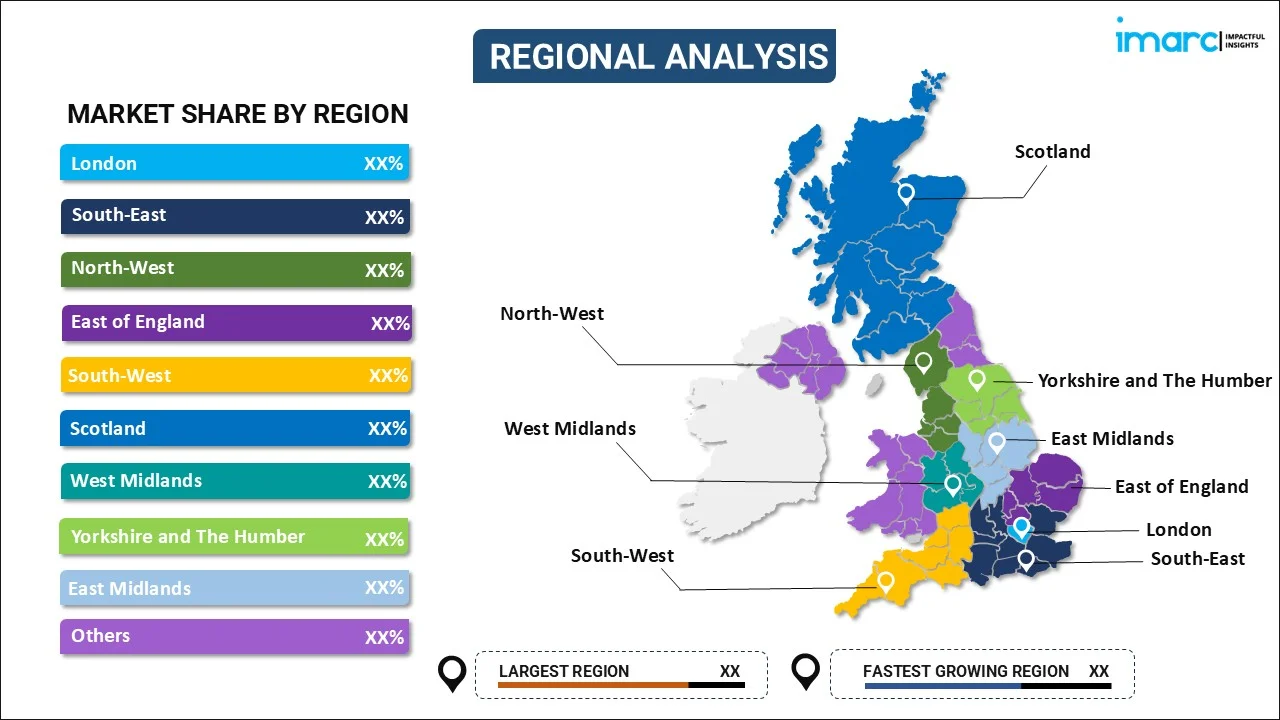
UK Peer-to-Peer Lending Market Size, Share, Trends and Forecast by Loan Type, Business Model, End User, and Region, 2025-2033
UK Peer-to-Peer Lending Market Overview:
The UK peer-to-peer lending market size reached USD 473.20 Million in 2024. Looking forward, IMARC Group expects the market to reach USD 617.60 Million by 2033, exhibiting a growth rate (CAGR) of 2.70% during 2025-2033. The demand is fueled by the rising availability of credit to underserved borrowers, the better returns over traditional savings, the growing need for small business loans, the favorable regulatory environment, the rising awareness of the advantages of P2P lending, the portfolio diversification of investors, and the ongoing improvements in lending technology.
|
Report Attribute
|
Key Statistics
|
|---|---|
|
Base Year
|
2024 |
|
Forecast Years
|
2025-2033
|
|
Historical Years
|
2019-2024
|
| Market Size in 2024 | USD 473.20 Million |
| Market Forecast in 2033 | USD 617.60 Million |
| Market Growth Rate (2025-2033) | 2.70% |
UK Peer-to-Peer Lending Market Trends:
Rapid technological advancements
Technological advancements are central to the growth of peer-to-peer lending market. The use of online platforms and digital infrastructure has made it possible for lenders and borrowers to interact directly, eliminating intermediaries. Advanced algorithms and data analysis have also made it possible to conduct efficient credit risk assessment, enhancing the overall efficiency and timeliness of lending. The growth of the business of peer-to-peer lending is being driven by the potential of higher yields for lenders compared to conventional investment avenues. P2P lending platforms have found favor because they offer more transparency and easier loan application procedures. These websites allow borrowers to compare loan terms, interest rates, and charges from various sources, making it easier for them to make informed choices. Through providing transparent and easy-to-use information, P2P lending websites enable lenders to examine and select the optimum loan offers that suit their conditions. For instance, according to industry reports, PeerBerry, a digital investment platform from Croatia, is increasing its stature by linking investors with originators in various countries. It features auto-invest functionalities as well as varied opportunities in digital consumer, business, real estate, and leasing loans. Additionally, the abbreviated application process is done online, which minimizes the use of extensive paperwork and lengthy processes. This, in turn, is likely to give a fillip to the market.
Increasing demand for alternative investment options
Growing demand for alternative investments is a major impetus behind growth in the UK peer-to-peer (P2P) lending industry. For instance, according to industry reports, P2P lending has emerged as the UK's fastest-growing alternative investment, with a 243% surge in search interest over the past year. Investment instruments such as stocks, bonds, and even savings accounts have not been able to provide the anticipated returns to the investors because of economic downturns and the current low interest rates. Therefore, investors have been looking for alternatives that promise better returns while they are effectively managing their portfolios. P2P lending websites are attractive to retail and institutional investors alike since they yield more returns than is possible in regular financial products. Investors on such sites play the role of lender to individuals or small companies, earning market-determined interest rates without any middlemen, giving them increased control and transparency through the ability to select borrowers along risk, loan duration, and desired returns. As increasing investors seek alternative options for portfolio diversification and improved returns, P2P lending has gained popularity, driving the UK market forward.
UK Peer-to-Peer Lending Market Segmentation:
IMARC Group provides an analysis of the key trends in each segment of the market, along with forecasts at the country level for 2025-2033. Our report has categorized the market based on loan type, business model, and end user.
Loan Type Insights:

- Consumer Lending
- Business Lending
The report has provided a detailed breakup and analysis of the market based on the loan type. This includes consumer lending and business lending.
Business Model Insights:
- Marketplace Lending
- Traditional Lending
A detailed breakup and analysis of the market based on the business model have also been provided in the report. This includes marketplace lending and traditional lending.
End User Insights:
- Consumer (Individual/Households)
- Small Businesses
- Large Businesses
- Real Estate
- Others
The report has provided a detailed breakup and analysis of the market based on the end user. This includes consumer (individual/households), small businesses, large businesses, real estate, and others.
Regional Insights:

- London
- South East
- North West
- East of England
- South West
- Scotland
- West Midlands
- Yorkshire and The Humber
- East Midlands
- Others
The report has also provided a comprehensive analysis of all the major regional markets, which include London, South East, North West, East of England, South West, Scotland, West Midlands, Yorkshire and The Humber, East Midlands, and others.
Competitive Landscape:
The market research report has also provided a comprehensive analysis of the competitive landscape. Competitive analysis such as market structure, key player positioning, top winning strategies, competitive dashboard, and company evaluation quadrant has been covered in the report. Also, detailed profiles of all major companies have been provided.
UK Peer-to-Peer Lending Market News:
- In February 2024, Funding Circle, a notable SME lending platform in the UK, announced a new partnership with Barclays Bank and TPG Angelo Gordon. This collaboration will deliver £300 million in funding to support small businesses across the country, enhancing access to finance for growing enterprises.
- In February 2023, Experian announced partnership with Zopa Bank to integrate Experian Boost data into Zopa’s credit card decision process, providing customers with improved credit options and lower APR rates. This collaboration supports financial inclusion by enabling users to enhance their credit scores through real-time transactional data shared via Open Banking. The partnership aims to offer more personalized, accessible credit options in the UK peer-to-peer lending market, reinforcing Zopa's commitment to fairness and customer-centric services.
UK Peer-to-Peer Lending Market Report Coverage:
| Report Features | Details |
|---|---|
| Base Year of the Analysis | 2024 |
| Historical Period | 2019-2024 |
| Forecast Period | 2025-2033 |
| Units | Million USD |
| Scope of the Report |
Exploration of Historical Trends and Market Outlook, Industry Catalysts and Challenges, Segment-Wise Historical and Future Market Assessment:
|
| Loan Types Covered | Consumer Lending, Business Lending |
| Business Models Covered | Marketplace Lending, Traditional Lending |
| End Users Covered | Consumer (Individual/Households), Small Businesses, Large Businesses, Real Estate, Others |
| Regions Covered | London, South East, North West, East of England, South West, Scotland, West Midlands, Yorkshire and The Humber, East Midlands, Others |
| Customization Scope | 10% Free Customization |
| Post-Sale Analyst Support | 10-12 Weeks |
| Delivery Format | PDF and Excel through Email (We can also provide the editable version of the report in PPT/Word format on special request) |
Key Questions Answered in This Report:
- How has the UK peer-to-peer lending market performed so far and how will it perform in the coming years?
- What is the breakup of the UK peer-to-peer lending market on the basis of loan type?
- What is the breakup of the UK peer-to-peer lending market on the basis of business model?
- What is the breakup of the UK peer-to-peer lending market on the basis of end user?
- What is the breakup of the UK peer-to-peer lending market on the basis of region?
- What are the various stages in the value chain of the UK peer-to-peer lending market?
- What are the key driving factors and challenges in the UK peer-to-peer lending?
- What is the structure of the UK peer-to-peer lending market and who are the key players?
- What is the degree of competition in the UK peer-to-peer lending market?
Key Benefits for Stakeholders:
- IMARC’s industry report offers a comprehensive quantitative analysis of various market segments, historical and current market trends, market forecasts, and dynamics of the UK peer-to-peer lending market from 2019-2033.
- The research report provides the latest information on the market drivers, challenges, and opportunities in the UK peer-to-peer lending market.
- Porter's five forces analysis assist stakeholders in assessing the impact of new entrants, competitive rivalry, supplier power, buyer power, and the threat of substitution. It helps stakeholders to analyze the level of competition within the UK peer-to-peer lending industry and its attractiveness.
- Competitive landscape allows stakeholders to understand their competitive environment and provides an insight into the current positions of key players in the market.
Need more help?
- Speak to our experienced analysts for insights on the current market scenarios.
- Include additional segments and countries to customize the report as per your requirement.
- Gain an unparalleled competitive advantage in your domain by understanding how to utilize the report and positively impacting your operations and revenue.
- For further assistance, please connect with our analysts.
 Request Customization
Request Customization
 Speak to an Analyst
Speak to an Analyst
 Request Brochure
Request Brochure
 Inquire Before Buying
Inquire Before Buying




.webp)




.webp)












